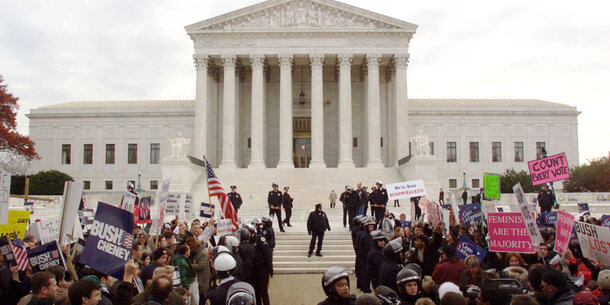The 2022 campaign presented the political press corps with an unprecedented challenge — how to cover candidates who deny the validity of elections. Repeating the unfounded claims that Joe Biden was not legitimately elected in 2020 is a political stance far different than, say, advocating for lower taxes or wanting to restrict abortion rights. Election deniers challenge the very premise of democracy, while candidate debates over government spending and social issues represent the essence of what democracy is all about. As such, media coverage of election denial candidates should appropriately reflect just how antithetical their views are to the normal political process.
In the end, the 2022 elections proved unkind to election deniers as voters rejected most of the prominent proponents of these false charges. But for the mainstream media, the issues raised by candidates decrying a “stolen election” did not end on November 8. The validity of the 2020 presidential race will likely continue to be questioned in future election campaigns. Moreover, other analogous antidemocratic challenges may also emerge in 2024 and beyond. It is not hard to imagine the rise of 2024 candidates who echo Donald Trump in talking about suspending parts of the Constitution or even discussing the merits of a military coup. So it remains relevant to question what standards political reporters should employ in chronicling the campaigns of candidates who undermine American democracy itself.
Looking at the midterms in hindsight, the news media has scant reason to feel smug about its coverage of election conspiracy theorists. In many cases, election deniers were treated as ordinary candidates, with their extreme views on the presidential election only mentioned in stories when the 2020 results were raised on the campaign trail or highlighted in a debate.
To scrutinize the journalistic treatment of election deniers, I examined local media coverage in the closing weeks of the campaigns of four election denial candidates for governor. Gubernatorial candidates were chosen because governors have far more sway over election administration than senators and garner far more press coverage than contenders for other relevant statewide offices, such as secretary of state. All four states that were studied — Arizona, Michigan, Wisconsin, and Pennsylvania — were closely contested in the 2020 presidential race and are likely to be again in 2024. These are the candidates focused on:
- Kari Lake of Arizona was one of the most outspoken election deniers on any ballot in 2022. She frequently referred to Biden as an “illegitimate president” and insisted, contrary to evidence, that the January 6 insurrectionists were “invited in by the Capitol police.” After losing her gubernatorial bid, Lake filed a lawsuit to overturn the state’s results. Though a state judge dismissed her electoral challenge, Lake appealed the decision in late December.
- Michigan’s Tudor Dixon repeatedly said during campaign debates that Donald Trump won the 2020 election. She also insisted that Trump carried Michigan, a state where, in reality, Biden prevailed by more than 150,000 votes.
- Tim Michels in Wisconsin repeatedly hinted that the 2020 election was stolen, with comments such as, “President Trump probably would be president right now if we had election integrity.” Michels also said he would be “open” to overturning the results of the 2020 election in Wisconsin, a state that Biden carried. And in the closing days of the campaign, Michels ominously, if somewhat ambiguously, claimed, “Republicans will never lose another election in Wisconsin after I’m elected governor.”
- Doug Mastriano, a Pennsylvania state senator and ardent election denier, attended the January 6 “Stop the Steal” rally in Washington that preceded the assault on the Capitol.
The methodology for this paper was to read and analyze every news story and news analysis piece during the three weeks before Election Day in each of the four states’ leading newspapers: the Arizona Republic, Detroit Free Press, Milwaukee Journal Sentinel, and Philadelphia Inquirer. Yes, regional newspapers have been hollowed out and have but a fraction of their former readership. But even in their diminished condition, these newspapers shape political attitudes and heavily influence television coverage in their states. By chance, all of these newspapers except for the Philadelphia Inquirer are owned by Gannett. To make sure that the trends in coverage that I noted are not limited to Gannett papers, I also examined news stories in the Detroit News (owned by Digital First Media) about Tudor Dixon’s campaign.
Kari Lake
The Arizona Republic’s coverage of Lake in her unsuccessful battle against then-Secretary of State Katie Hobbs was ambivalent. The newspaper could be hard-hitting: An October 20 article by reporter Stacey Barchenger on election reforms began with Lake refusing to say that she would accept the results of her race and stressed in the third paragraph that the gubernatorial contest “seems like it has one foot in 2020, thanks in large part of Lake’s repeated false claims that Joe Biden was illegitimately elected.” Similarly, a news analysis by Barchenger that ran on October 30 was headlined “In Kari Lake’s campaign for governor, misinformation and deception remain hallmarks.”
But at other times, the Arizona Republic made it difficult for voters to learn that Lake’s views on democracy were outside the political mainstream. Lengthy compare-and-contrast articles on education (October 18) and the economy (October 19) outlined Lake’s and Hobbs’s views without giving the slightest hint that one of the two candidates trafficked in misinformation. Sometimes, the paper’s reporters merely played stenographers. For example, the final dispatch from the campaign trail on November 7 colorfully recounted a Phoenix rally in which Lake strode onstage with “American Woman” playing from the loudspeakers. Election denial was never mentioned.
Tudor Dixon
Perhaps because election denial was not regarded as central to Tudor Dixon’s political persona, Michigan voters had to work overtime to learn about her evidence-free comments about the validity of Biden’s presidency. When on October 19, the Free Press offered 500-word profiles of both Dixon and incumbent Gov. Gretchen Whitmer, there was not a single mention of the 2020 election. Similarly, a Free Press news analysis on November 6 posed 22 questions that would be answered by the 2022 verdict — both in Michigan and nationally — including the blunt query: “Can we move past the ’20 election?” But even that story offered no mention of Dixon’s views on a concocted “stolen election.”
It is plausible that Dixon’s electoral stance was downplayed by the Detroit newspapers because her views were not nearly as extreme as those of secretary of state candidate Kristina Karamo, who was running on the same ticket. But a more likely explanation is that reporters at both the Free Press and the Detroit News simply did what they do most often — cover the horse race, which elevates the drama of who is going to win over anything substantive.
A typical Free Press article on October 28 highlighted Dixon’s financial problems as she had raised only about one-eighth as much money as the incumbent governor. Such horse race pieces never mention Dixon’s extreme views on the 2020 election. Often, candidate coverage that doesn’t specifically pertain to election denialism simply reproduces what was said on the campaign trail. The opening words of a Detroit News article on the Sunday before the election conveyed this stenographic style of coverage: “Gov. Gretchen Whitmer and . . . challenger Tudor Dixon both contended they were problem solvers Sunday during some of their final campaign stops before Election Day.”
Tim Michels
The Milwaukee Journal Sentinel was even more muted in its coverage of Tim Michels’s history of election denial. A nearly 2,000-word profile of Michels from October 28 never mentioned his views on overturning the 2020 election. Five paragraphs from the bottom of the article, the supposedly in-depth profile stated, “Michels prefers not to talk about abortion and instead focuses on crime, education, the economy and what he calls ‘election integrity,’ all issues for which he has created ‘blueprints.’” That glancing two-word reference to “election integrity,” which was not explained further, represented the only hint that Michels harbors major doubts about the results of the 2020 election.
This profile was emblematic of the way that Journal Sentinel skirted the issue. Three days before the election, the newspaper ran an article titled “Tim Michels is calling for big changes in Wisconsin from taxes to elections to education, but offers few details on his plans.” That story mentioned in passing that Michels promised “to repeal every rule local election clerks follow to administer elections.” But the piece quickly moved on to quote a political science professor saying that deliberate vagueness was Michels’s strategy to hold together “a coalition of supporters who range from 2020 election deniers . . . to fiscal conservatives who do not approve of Trump.” Even a November 4 news story contrasting Michels’s and Evans’s views on the conduct of elections in Wisconsin devoted just a single sentence to Michels’s insistence that “he is open to overturning the 2020 election result, despite the move being impossible two years after the fact.”
Doug Mastriano
In contrast to the understated and uninformative daily coverage of Dixon and Michels, the Philadelphia Inquirer’s treatment of Doug Mastriano in its news columns was refreshing in its blunt recognition that his was not a normal political campaign. Mastriano, to be sure, made it easy for the Inquirer with his flirtation with QAnon adherents and the prominent roles in his campaign played by extreme election deniers.
A full-length October 18 profile of Mastriano by reporter Chris Brennan reflected the tenor of the Inquirer’s coverage. The article highlighted Mastriano’s uncooperative appearance before the January 6 committee, and it reminded readers that “Mastriano supported efforts to have the legislature send a pro-Trump slate of electors to Congress, spoke with Trump in the aftermath of the election, and was present on Capitol grounds the day of the riot.”
Again and again, the Inquirer stressed that Mastriano’s views on the 2020 election were both extreme and fallacious. A capsule portrait of Mastriano in an October 25 article, billed as a “Voter’s Guide,” described him as “one of the most prominent election deniers in Pennsylvania.” That story was followed by an October 26 look at the volunteers who were powering Mastriano’s underfunded campaign. The piece emphasized that the candidate had built a passionate right-wing following through “his efforts to overturn the results of the 2020 presidential election, echoing Trump’s false claims of widespread voter fraud.” In a similar fashion, a November 1 article on Democrats campaigning in deeply Republican areas succinctly described Mastriano as a “QAnon supporter and Capitol insurrectionist.”
• • •
The news business, with its emphasis on what just occurred, has a built-in bias against repetition. Writing a story a second time — even if such a story is necessary to provide context — can be dismissed as “old news.”
The unfortunate result of this journalistic reflex was that “election denial” as an issue became siloed off in the coverage of gubernatorial races in Arizona, Michigan, and Wisconsin. To their credit, the Arizona Republic, the two Detroit newspapers, and the Milwaukee Journal Sentinel all ran detailed stories on the records of gubernatorial candidates peddling discredited conspiracy theories about the 2020 election. But once having written those articles, the newspapers then avoided referring to election denial on a regular basis. As a result, a voter who had read up on, say, the economic policies of Kari Lake or the educational proposals of Tim Michels would have no idea that either candidate was also fueling “stolen election” conspiracy theories.
Journalistic passivity played a role here. As I have observed over a half century of writing about politics, many political reporters and editors believe that the candidates themselves should frame the contours of campaign coverage, with journalists only emphasizing the topics being raised in battling TV ads and in debates. Under this mistaken reasoning, election denial only becomes a major issue if it is stressed by the candidate or their rival. The allure of horse race coverage also contributed to downplaying the extremism of candidates who refuse to accept Biden as the legitimately elected president.
That’s why the Philadelphia Inquirer should serve as a model for future coverage of candidates who challenge the basic premises of American democracy. The Inquirer took pains to convey Doug Mastriano’s outside-the-mainstream views in almost every article about his campaign. “QAnon supporter and Capitol insurrectionist” became as much a part of Mastriano’s political identity in the Inquirer as his day job as a state senator. These aspects of Mastriano’s persona obviously did not have to be the centerpiece of every article, but they rightfully should have been mentioned as often as possible.
One of the biggest challenges facing the political press corps in the years ahead is to avoid normalizing candidates who cast doubt on the integrity of our election system. Consistently telling the truth about such election deniers and Constitution rejectors remains the best way to inform voters. And the essence of democracy is trusting voters to make the right decisions once they have all the facts at their disposal.



